Regulation of the Gene for Alanine Racemase Modulates Amino Acid Metabolism with Consequent Alterations in Cell Wall Properties and Adhesive Capability in Brucella spp.
Abstract
1. Introduction
2. Results
2.1. The Alr Protein Is Highly Conserved in Brucella
2.2. Physical and Biochemical Properties of the Alr Protein
2.3. Structure Predictions of Alr
2.4. Numerous Metabolites Are Upregulated and Downregulated in B. suis Δalr through Liquid Chromatography–Mass Spectrometry (LC-MS)
2.5. Differential Metabolite Screening Refines Upregulated and Downregulated Metabolites in B. suis Deleted from the alr Gene
2.6. Differentially Abundant Metabolite Analysis of Diverse Metabolite Comparison Groups
2.7. Correlation Analysis of DAMs Reveals Metabolic Changes in B. suis Δalr to Maintain Survival
2.8. KEGG Enrichment Analysis Demonstrates Altered Amino Acid Pathways in B. suis Δalr
2.9. Deletion of Alr Reduces Stress Resistance of B. suis S2
2.10. Transmission Electron Microscopy Analysis Reveals Cell Wall Defects in the Alr Mutant Strain
2.11. Deletion of Alr Alters Cell Surface Hydrophobicity
2.12. The Zeta Potential of Wild-Type and Δalr Strains Differs in the Simulated Intracellular Environment
2.13. Effects of Intracellular Environment on Membrane Integrity in B. suis Δalr
2.14. Changes in Membrane Integrity Observed by Fluorescence Microscopy
2.15. The Alr Deletion Induces Release of Membrane-Bound Alkaline Phosphatase and Intracellular Lactate Dehydrogenase
2.16. Deletion of the alr Gene Reduces Host Cell Adhesion
3. Discussion
4. Materials and Methods
4.1. Bioinformatics Analysis of the Alr Protein
4.2. Biosafety Statement
4.3. Bacterial Strains
4.4. Sample Preparation for Liquid Chromatography–Mass Spectrometry
4.5. LC–MS and Data Processing
4.6. LC–MS Data Statistical Analysis
4.7. Analysis of the Growth of B. suis Strains
4.8. Brucella Stress Resistance Tests
4.9. Transmission Electron Microscopy
4.10. Determination of Cell Surface Hydrophobicity
4.11. Measurement of Zeta Potential
4.12. Alkaline Phosphatase Assay
4.13. Lactate Dehydrogenase Assay
4.14. Determination of Membrane Permeability
4.15. Fluorescence Microscopy
4.16. Immunofluorescence Assay
4.17. Enumeration of B. suis S2 in Infected RAW264.7 Cells
4.18. Statistical Analysis
Supplementary Materials
Author Contributions
Funding
Institutional Review Board Statement
Informed Consent Statement
Data Availability Statement
Acknowledgments
Conflicts of Interest
References
- Pappas, G.; Papadimitriou, P.; Akritidis, N.; Christou, L.; Tsianos, E.V. The new global map of human brucellosis. Lancet Infect. Dis. 2006, 6, 91–99. [Google Scholar] [CrossRef] [PubMed]
- Jiao, H.; Zhou, Z.; Li, B.; Xiao, Y.; Li, M.; Zeng, H.; Guo, X.; Gu, G. The Mechanism of Facultative Intracellular Parasitism of Brucella. Int. J. Mol. Sci. 2021, 22, 3673. [Google Scholar] [CrossRef] [PubMed]
- Li, J.; Qi, L.; Diao, Z.; Zhang, M.; Li, B.; Zhai, Y.; Hao, M.; Zhou, D.; Liu, W.; Jin, Y.; et al. Brucella BtpB Manipulates Apoptosis and Autophagic Flux in RAW264.7 Cells. Int. J. Mol. Sci. 2022, 23, 14439. [Google Scholar] [CrossRef] [PubMed]
- Bialer, M.G.; Sycz, G.; Muñoz González, F.; Ferrero, M.C. Adhesins of Brucella: Their Roles in the Interaction with the Host. Pathogens 2020, 9, 942. [Google Scholar] [CrossRef]
- Czibener, C.; Merwaiss, F.; Guaimas, F.; Del Giudice, M.G.; Serantes, D.A.; Spera, J.M.; Ugalde, J.E. BigA is a novel adhesin of Brucella that mediates adhesion to epithelial cells. Cell. Microbiol. 2016, 18, 500–513. [Google Scholar] [CrossRef]
- Jørgensen, B.B.; Boetius, A. Feast and famine—Microbial life in the deep-sea bed. Nat. Rev. Microbiol. 2007, 5, 770–781. [Google Scholar] [CrossRef]
- Hener, C.; Hummel, S.; Suarez, J.; Stahl, M.; Kolukisaoglu, Ü. d-Amino Acids Are Exuded by Arabidopsis thaliana Roots to the Rhizosphere. Int. J. Mol. Sci. 2018, 19, 1109. [Google Scholar] [CrossRef]
- Yu, C.; Li, X.; Zhang, N.; Wen, D.; Liu, C.; Li, Q. Inhibition of biofilm formation by D-tyrosine: Effect of bacterial type and D-tyrosine concentration. Water Res. 2016, 92, 173–179. [Google Scholar] [CrossRef]
- Shrestha, R.; Lockless, S.W.; Sorg, J.A. A Clostridium difficile alanine racemase affects spore germination and accommodates serine as a substrate. J. Biol. Chem. 2017, 292, 10735–10742. [Google Scholar] [CrossRef]
- Wei, Y.; Qiu, W.; Zhou, X.D.; Zheng, X.; Zhang, K.K.; Wang, S.D.; Li, Y.Q.; Cheng, L.; Li, J.Y.; Xu, X.; et al. Alanine racemase is essential for the growth and interspecies competitiveness of Streptococcus mutans. Int. J. Oral Sci. 2016, 8, 231–238. [Google Scholar] [CrossRef]
- Choi, S.H.; Kim, K.H. Generation of two auxotrophic genes knock-out Edwardsiella tarda and assessment of its potential as a combined vaccine in olive flounder (Paralichthys olivaceus). Fish Shellfish. Immunol. 2011, 31, 58–65. [Google Scholar] [CrossRef] [PubMed]
- Zai, X.; Yang, Q.; Yin, Y.; Li, R.; Qian, M.; Zhao, T.; Li, Y.; Zhang, J.; Fu, L.; Xu, J.; et al. Relative Quantitative Proteomic Analysis of Brucella abortus Reveals Metabolic Adaptation to Multiple Environmental Stresses. Front. Microbiol. 2017, 8, 2347. [Google Scholar] [CrossRef] [PubMed]
- Chen, L.C.; Kung, S.K.; Chen, H.H.; Lin, S.B. Evaluation of zeta potential difference as an indicator for antibacterial strength of low molecular weight chitosan. Carbohydr. Polym. 2010, 82, 913–919. [Google Scholar] [CrossRef]
- Zhang, G.; Zhong, F.; Chen, L.; Qin, P.; Li, J.; Zhi, F.; Tian, L.; Zhou, D.; Lin, P.; Chen, H.; et al. Integrated Proteomic and Transcriptomic Analyses Reveal the Roles of Brucella Homolog of BAX Inhibitor 1 in Cell Division and Membrane Homeostasis of Brucella suis S2. Front. Microbiol. 2021, 12, 632095. [Google Scholar] [CrossRef]
- Chen, C.Z.; Cooper, S.L. Interactions between dendrimer biocides and bacterial membranes. Biomaterials 2002, 23, 3359–3368. [Google Scholar] [CrossRef]
- Yan, L.; Zhang, S.; Zhou, X.; Tian, S. Anti-biofilm and bacteriostatic effects of three flavonoid compounds on Streptococcus mutans. Biofouling 2023, 39, 245–256. [Google Scholar] [CrossRef]
- Tassoni, R.; van der Aart, L.T.; Ubbink, M.; van Wezel, G.P.; Pannu, N.S. Structural and functional characterization of the alanine racemase from Streptomyces coelicolor A3(2). Biochem. Biophys. Res. Commun. 2017, 483, 122–128. [Google Scholar] [CrossRef]
- Zajdowicz, S.L.; Jones-Carson, J.; Vazquez-Torres, A.; Jobling, M.G.; Gill, R.E.; Holmes, R.K. Alanine racemase mutants of Burkholderia pseudomallei and Burkholderia mallei and use of alanine racemase as a non-antibiotic-based selectable marker. PLoS ONE 2011, 6, e21523. [Google Scholar] [CrossRef][Green Version]
- Hammes, W.; Schleifer, K.H.; Kandler, O. Mode of Action of Glycine on the Biosynthesis of Peptidoglycan. J. Bacteriol. 1973, 116, 1029–1053. [Google Scholar] [CrossRef]
- Caparrós, M.; Pisabarro, A.G.; Pedro, M.A.D. Effect of D-amino acids on structure and synthesis of peptidoglycan in Escherichia coli. J. Bacteriol. 1992, 174, 5549–5559. [Google Scholar] [CrossRef]
- Peng, B.; Congrui, Z.; Shaojuan, L.; Zhendong, L.; Wenkai, R.; Guoqiang, Z. Perspective: Methionine Restriction–Induced Longevity—A Possible Role for Inhibiting the Synthesis of Bacterial Quorum Sensing Molecules. Adv. Nutr. 2020, 4, 773–783. [Google Scholar]
- Soutourina, O.; Poupel, O.; Coppée, J.Y.; Danchin, A.; Msadek, T.; Martin-Verstraete, I. CymR, the master regulator of cysteine metabolism in Staphylococcus aureus, controls host sulphur source utilization and plays a role in biofilm formation. Mol. Microbiol. 2009, 73, 194–211. [Google Scholar] [CrossRef] [PubMed]
- Choi, T.R.; Song, H.S.; Han, Y.H.; Park, Y.L.; Park, J.Y.; Yang, S.Y.; Bhatia, S.K.; Gurav, R.; Kim, H.J.; Lee, Y.K.; et al. Enhanced tolerance to inhibitors of Escherichia coli by heterologous expression of cyclopropane-fatty acid-acyl-phospholipid synthase (cfa) from Halomonas socia. Bioprocess Biosyst. Eng. 2020, 43, 909–918. [Google Scholar] [CrossRef] [PubMed]
- Barbier, T.; Zúñiga-Ripa, A.; Moussa, S.; Plovier, H.; Sternon, J.F.; Lázaro-Antón, L.; Conde-Álvarez, R.; De Bolle, X.; Iriarte, M.; Moriyón, I.; et al. Brucella central carbon metabolism: An update. Crit. Rev. Microbiol. 2018, 44, 182–211. [Google Scholar] [CrossRef] [PubMed]
- Liu, D.; Zhang, T.; Wang, Y.; Muhammad, M.; Xue, W.; Ju, J.; Zhao, B. Knockout of alanine racemase gene attenuates the pathogenicity of Aeromonas hydrophila. BMC Microbiol. 2019, 19, 72. [Google Scholar] [CrossRef]
- Kang, L.; Shaw, A.C.; Xu, D.; Xia, W.; Zhang, J.; Deng, J.; Wöldike, H.F.; Liu, Y.; Su, J. Upregulation of MetC is essential for D-alanine-independent growth of an alr/dadX-deficient Escherichia coli strain. J. Bacteriol. 2011, 193, 1098–1106. [Google Scholar] [CrossRef]
- Ma, Q.; Pan, Y.; Chen, Y.; Yu, S.; Huang, J.; Liu, Y.; Gong, T.; Zhang, Q.; Sun, Q.; Zou, J.; et al. Acetylation of Lactate Dehydrogenase Negatively Regulates the Acidogenicity of Streptococcus mutans. mBio 2022, 13, e0201322. [Google Scholar] [CrossRef]
- Vandana; Das, S. Cell surface hydrophobicity and petroleum hydrocarbon degradation by biofilm-forming marine bacterium Pseudomonas furukawaii PPS-19 under different physicochemical stressors. J. Hazard. Mater. 2023, 457, 131795. [Google Scholar] [CrossRef]
- Zając, M.; Kotyńska, J.; Zambrowski, G.; Breczko, J.; Deptuła, P.; Cieśluk, M.; Zambrzycka, M.; Święcicka, I.; Bucki, R.; Naumowicz, M. Exposure to polystyrene nanoparticles leads to changes in the zeta potential of bacterial cells. Sci. Rep. 2023, 13, 9552. [Google Scholar] [CrossRef]
- Tanaka-Takemura, Y.; Arisaka, Y. Independent Roles of Molecular Mobility and Zeta Potential on Supramolecular Surfaces in the Sequence of RAW264.7 Macrophage Responses. Macromol. Biosci. 2022, 22, e2200282. [Google Scholar] [CrossRef]
- Arenas, G.N.; Staskevich, A.S.; Aballay, A.; Mayorga, L.S. Intracellular trafficking of Brucella abortus in J774 macrophages. Infect. Immun. 2000, 68, 4255–4263. [Google Scholar] [CrossRef] [PubMed]
- Copin, R.; Vitry, M.A.; Hanot Mambres, D.; Machelart, A.; De Trez, C.; Vanderwinden, J.M.; Magez, S.; Akira, S.; Ryffel, B.; Carlier, Y.; et al. In situ microscopy analysis reveals local innate immune response developed around Brucella infected cells in resistant and susceptible mice. PLoS Pathog. 2012, 8, e1002575. [Google Scholar] [CrossRef] [PubMed]
- Sha, T.; Li, Z.; Zhang, C.; Zhao, X.; Chen, Z.; Zhang, F.; Ding, J. Bioinformatics analysis of candidate proteins Omp2b, P39 and BLS for Brucella multivalent epitope vaccines. Microb. Pathog. 2020, 147, 104318. [Google Scholar] [CrossRef] [PubMed]
- Hao, M.; Wang, M.; Zhao, D.; Shi, Y.; Yuan, Y.; Li, J.; Zhai, Y.; Liu, X.; Zhou, D.; Chen, H. Alr Gene in Brucella suis S2: Its Role in Lipopolysaccharide Biosynthesis and Bacterial Virulence in RAW264.7. Int. J. Mol. Sci. 2023, 24, 10744. [Google Scholar] [CrossRef]
- Wu, Y.; Yang, H. Metabolite Profiling and Classification of Highbush Blueberry Leaves under Different Shade Treatments. Metabolites 2022, 12, 79. [Google Scholar] [CrossRef]
- Li, N.; Zhou, J.; He, C.; Fu, Y.; Wang, C.; Liu, L.; Meng, K.; Li, Y.; Zhu, Z.; Huang, L.; et al. GC-MS-based metabolomics reveal that light intensity during indoor overwintering affects the metabolism of Scylla paramamosain. Aquac. Res. 2021, 52, 1013–1025. [Google Scholar] [CrossRef]
- Cao, M.; Liu, Y.; Jiang, W.; Meng, X.; Xing, S. UPLC/MS-based untargeted metabolomics reveals the changes of metabolites profile of Salvia miltiorrhiza bunge during Sweating processing. Sci. Rep. 2020, 10, 19524. [Google Scholar] [CrossRef]
- Wu, Y.; Yang, H.; Yang, H.; Zhang, C.; Lyu, L.; Li, W.; Wu, W. A physiological and metabolomic analysis reveals the effect of shading intensity on blueberry fruit quality. Food Chem. X 2022, 15, 100367. [Google Scholar] [CrossRef]
- Wang, H.H.; Ye, K.P.; Zhang, Q.Q.; Dong, Y.; Zhou, G.H. Biofilm formation of meat-borne Salmonella enterica and inhibition by the cell-free supernatant from Pseudomonas aeruginosa. Food Control 2013, 32, 650–658. [Google Scholar] [CrossRef]


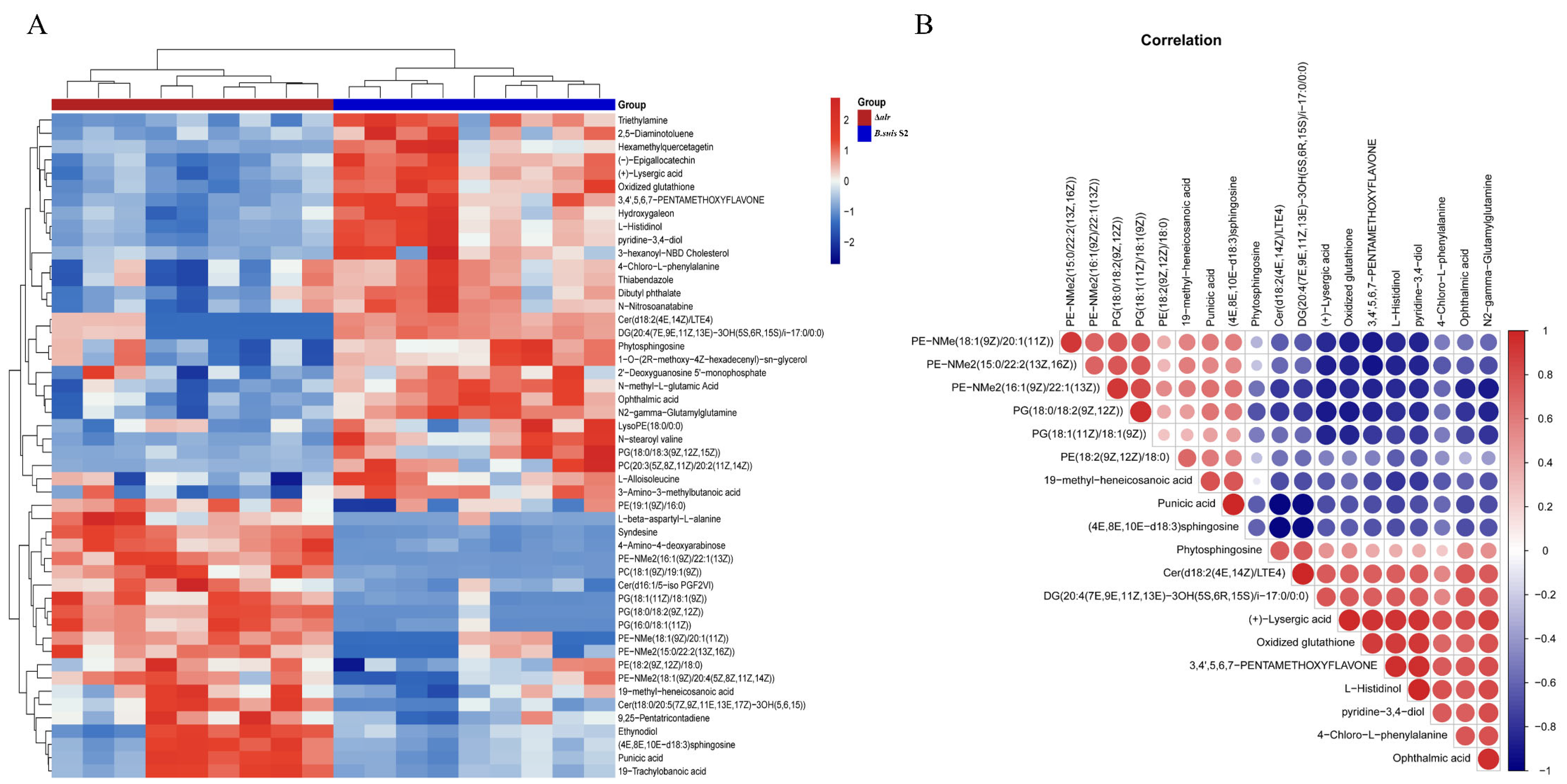
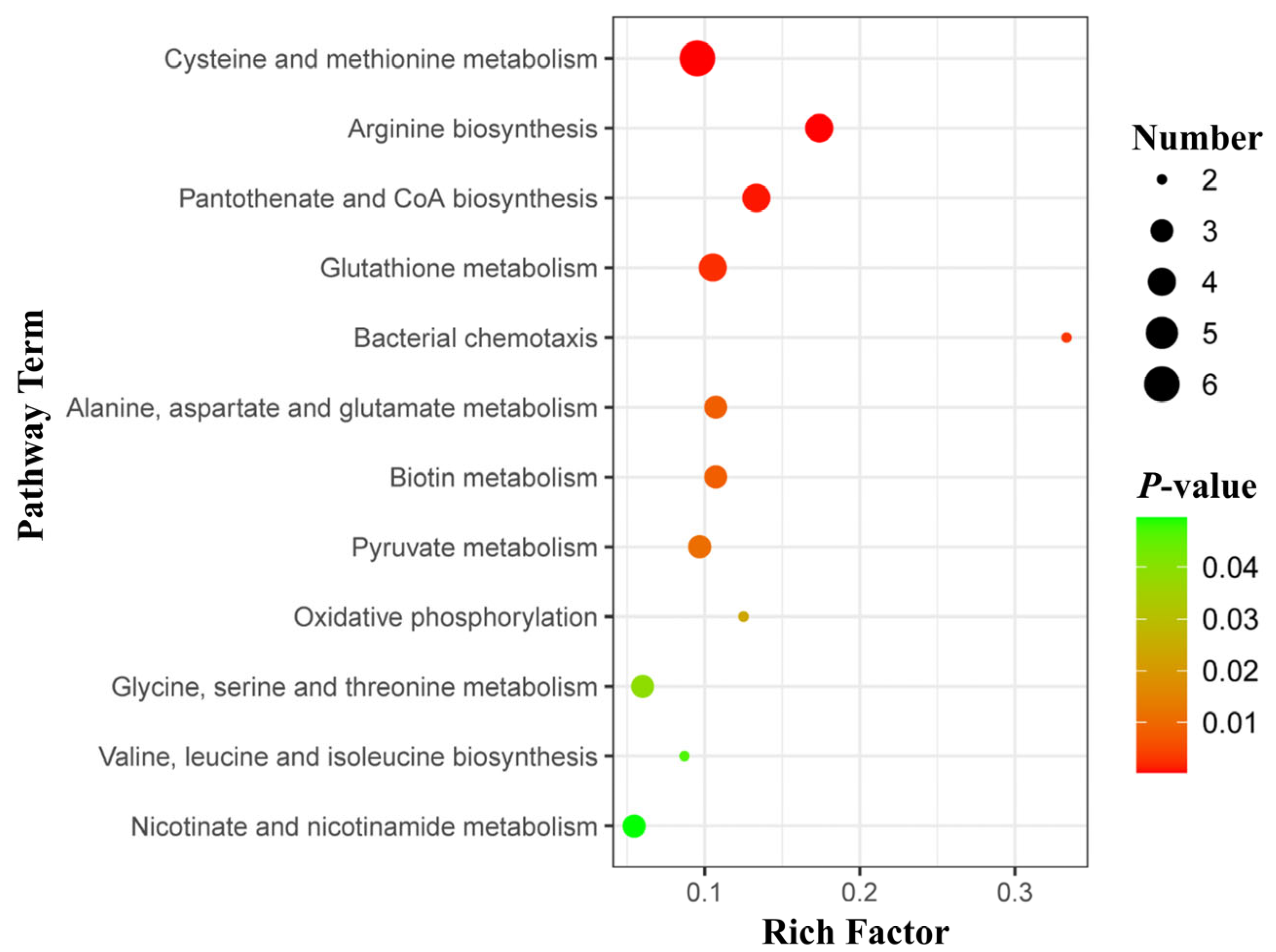
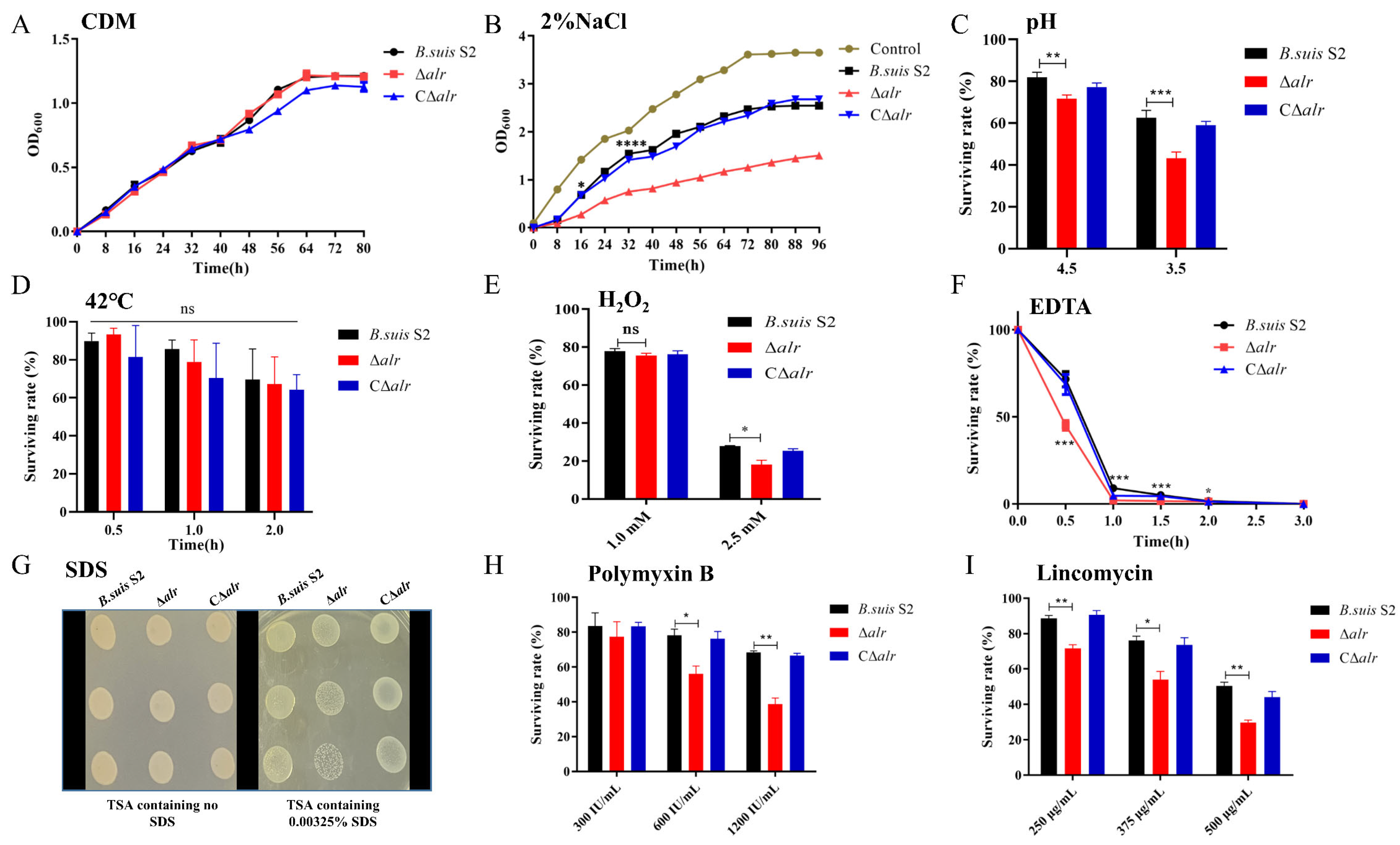

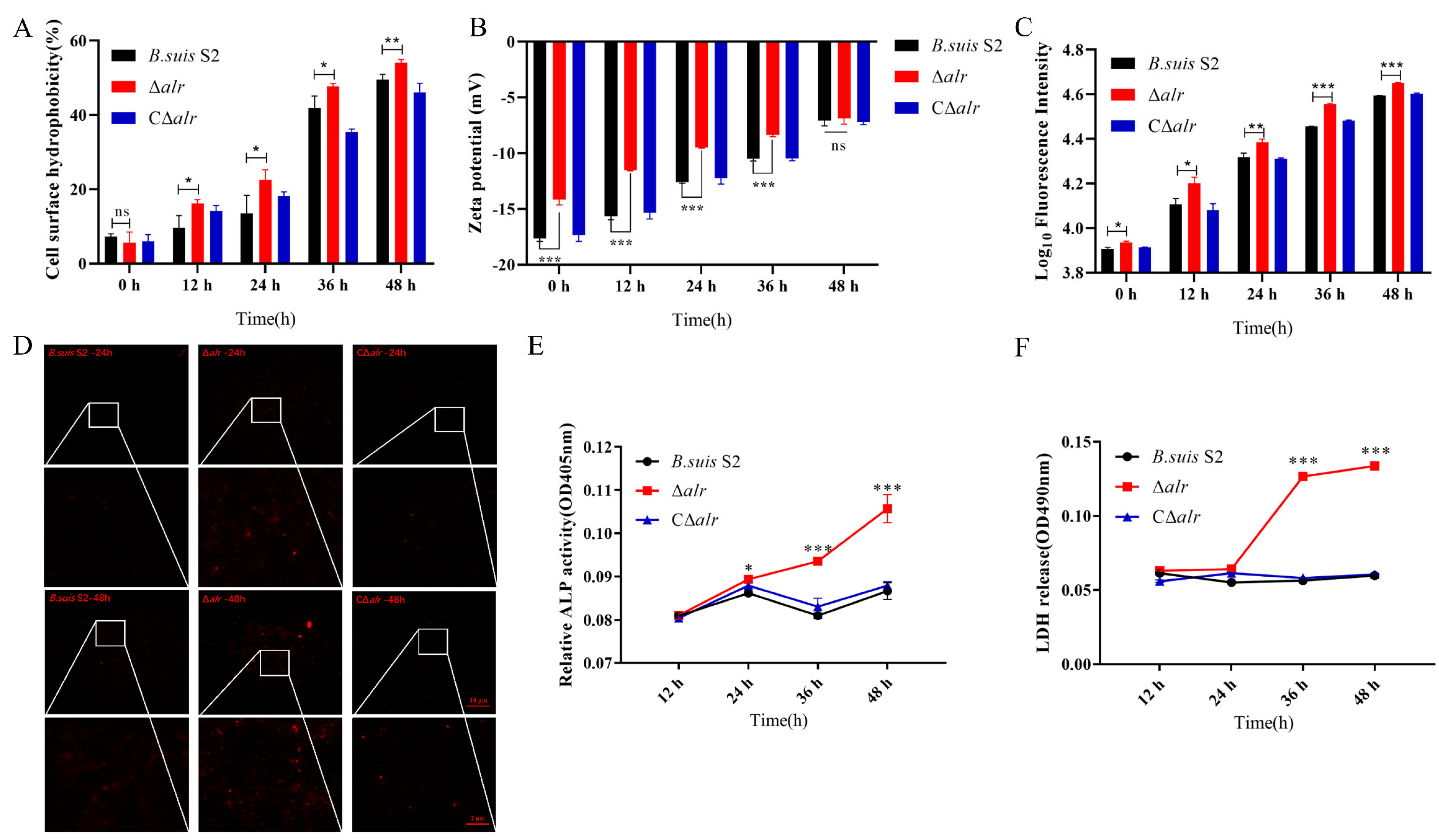
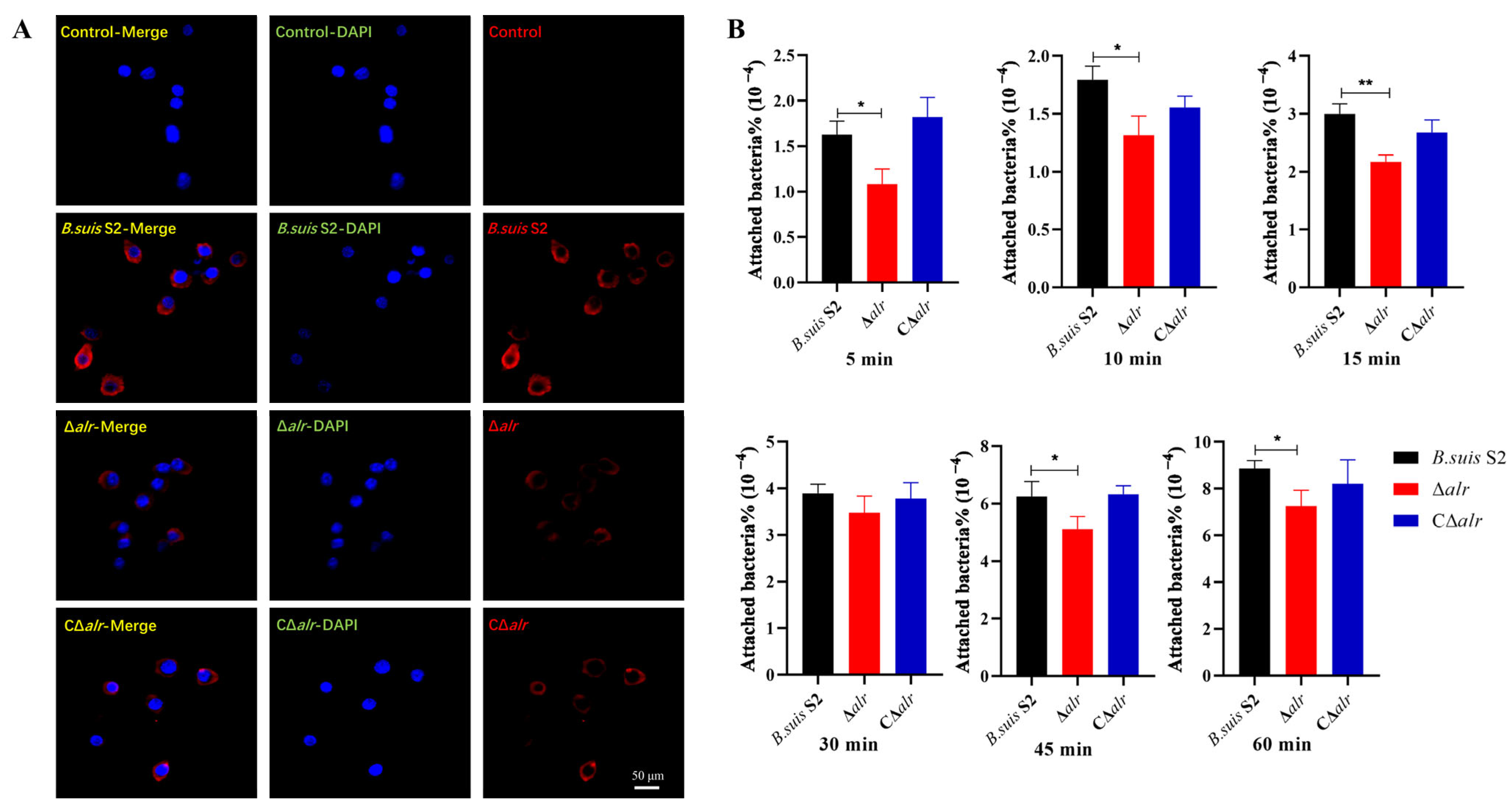
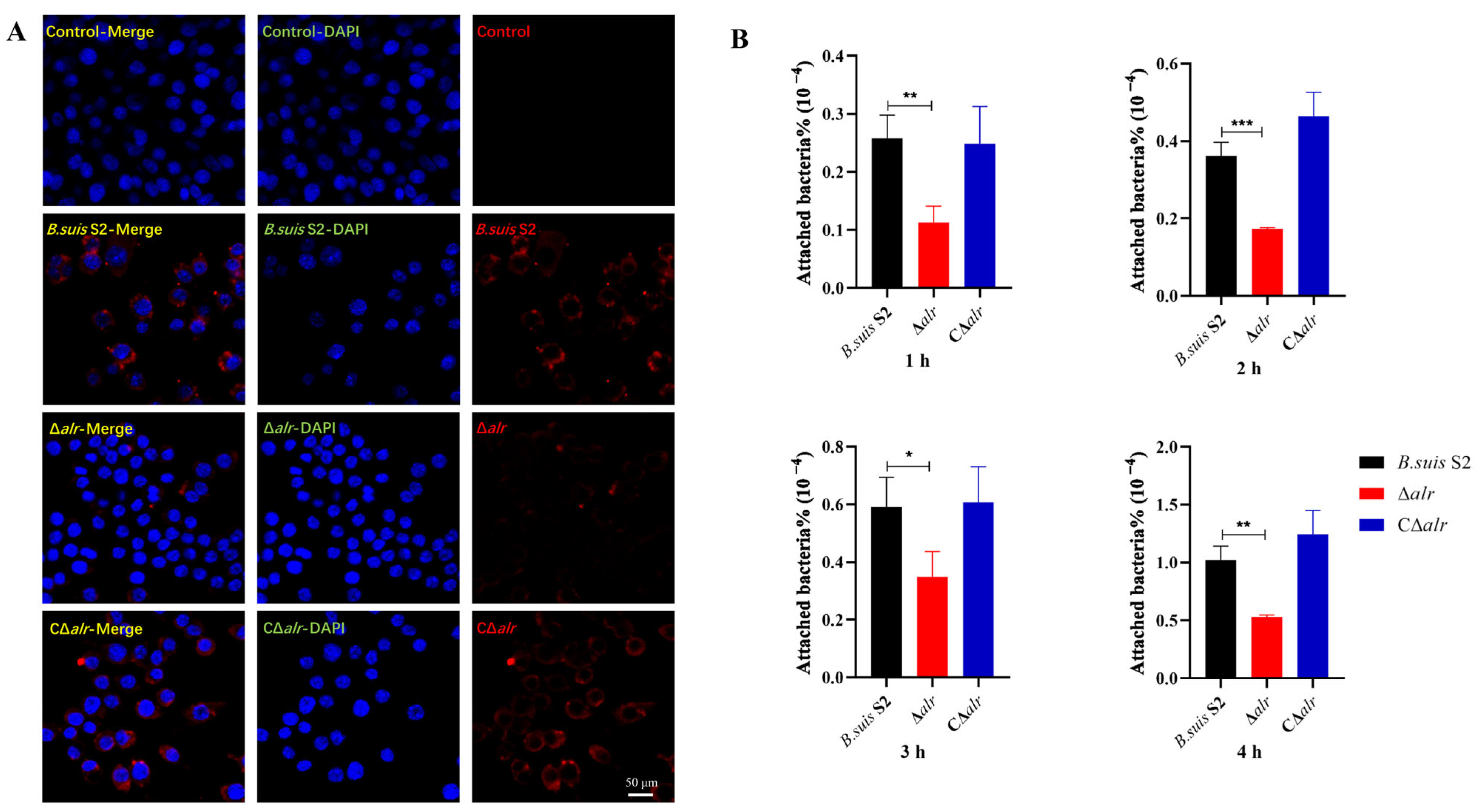
Disclaimer/Publisher’s Note: The statements, opinions and data contained in all publications are solely those of the individual author(s) and contributor(s) and not of MDPI and/or the editor(s). MDPI and/or the editor(s) disclaim responsibility for any injury to people or property resulting from any ideas, methods, instructions or products referred to in the content. |
© 2023 by the authors. Licensee MDPI, Basel, Switzerland. This article is an open access article distributed under the terms and conditions of the Creative Commons Attribution (CC BY) license (https://creativecommons.org/licenses/by/4.0/).
Share and Cite
Hao, M.; Wang, M.; Tang, T.; Zhao, D.; Yin, S.; Shi, Y.; Liu, X.; Wudong, G.; Yang, Y.; Zhang, M.; et al. Regulation of the Gene for Alanine Racemase Modulates Amino Acid Metabolism with Consequent Alterations in Cell Wall Properties and Adhesive Capability in Brucella spp. Int. J. Mol. Sci. 2023, 24, 16145. https://doi.org/10.3390/ijms242216145
Hao M, Wang M, Tang T, Zhao D, Yin S, Shi Y, Liu X, Wudong G, Yang Y, Zhang M, et al. Regulation of the Gene for Alanine Racemase Modulates Amino Acid Metabolism with Consequent Alterations in Cell Wall Properties and Adhesive Capability in Brucella spp. International Journal of Molecular Sciences. 2023; 24(22):16145. https://doi.org/10.3390/ijms242216145
Chicago/Turabian StyleHao, Mingyue, Minghui Wang, Ting Tang, Danyu Zhao, Shurong Yin, Yong Shi, Xiaofang Liu, Gaowa Wudong, Yuanhao Yang, Mengyu Zhang, and et al. 2023. "Regulation of the Gene for Alanine Racemase Modulates Amino Acid Metabolism with Consequent Alterations in Cell Wall Properties and Adhesive Capability in Brucella spp." International Journal of Molecular Sciences 24, no. 22: 16145. https://doi.org/10.3390/ijms242216145
APA StyleHao, M., Wang, M., Tang, T., Zhao, D., Yin, S., Shi, Y., Liu, X., Wudong, G., Yang, Y., Zhang, M., Qi, L., Zhou, D., Liu, W., Jin, Y., & Wang, A. (2023). Regulation of the Gene for Alanine Racemase Modulates Amino Acid Metabolism with Consequent Alterations in Cell Wall Properties and Adhesive Capability in Brucella spp. International Journal of Molecular Sciences, 24(22), 16145. https://doi.org/10.3390/ijms242216145






